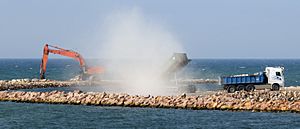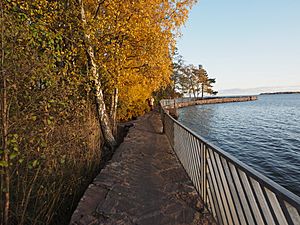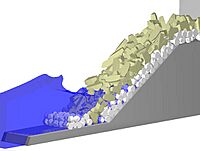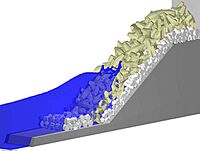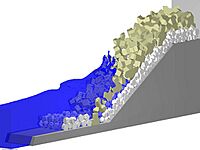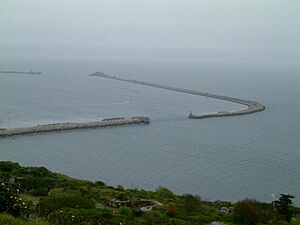Breakwater facts for kids
A breakwater is a strong structure built in coastal areas. Its main job is to protect the land and water from strong tides, currents, waves, and storm surges. People have built breakwaters for a very long time. They help keep boats safe in harbors by blocking rough waves.
Sometimes, a breakwater is called a jetty or a mole. It can be connected to the land or stand alone in the water. Some breakwaters even have a path or road on top for people or vehicles.
Breakwaters are part of a system to manage our coasts. They are often placed parallel to the shore to stop erosion. On beaches where sand moves away easily, smaller structures called groynes might be built. These are usually placed straight out from the beach into the water. They slow down the sand movement and help keep the beach material in place.
Contents
Why We Build Breakwaters
Breakwaters make the water calmer closer to shore. This creates a safe place for ships to anchor. An anchorage is only safe if ships are protected from powerful waves.
Natural harbors are often protected by things like headlands or reefs. But we can create artificial harbors using breakwaters. Even mobile harbors, like the D-Day Mulberry harbours, were used as floating breakwaters. Some natural harbors, like those in Plymouth Sound, have been made even better with rock breakwaters.
Breakwaters can also be smaller structures. These are designed to protect gently sloping beaches and reduce coastal erosion. They are often placed about 30 to 90 meters (100 to 300 feet) offshore in shallow water.
Different Kinds of Breakwaters
Breakwaters are built to absorb the energy of waves. They do this either by being very heavy, like with large concrete boxes, or by having a sloped surface made of rocks or concrete blocks.
In coastal engineering, a structure with land on one side is called a revetment. A breakwater has water on both sides.
Rubble Mound Breakwaters
Rubble mound breakwaters are made of piles of stones. They have spaces inside that help spread out the wave energy. Smaller stones form the center, and larger stones or concrete blocks protect the outside. These outer layers absorb most of the wave's power. The slopes of these structures are usually gentle. In shallow water, they are often quite cheap to build. But in deeper water, they need a lot more material, which makes them more expensive.
Caisson Breakwaters
Caisson breakwaters are usually big concrete boxes with straight sides. They are often built where ships need to dock right next to the breakwater. They use their heavy weight and the material inside them to resist the force of waves. They can be expensive in shallow water. But in deeper areas, they can be cheaper than rubble mound breakwaters.
Sometimes, a pile of rocks is placed in front of a caisson breakwater. This helps absorb wave energy and reduces how much waves bounce off the wall. This design offers extra protection on the sea side. It also provides a dock on the inner side, but it might cause more waves to wash over the top.
Wave-Absorbing Caissons
A more advanced type is the wave-absorbing caisson. These have special holes or openings in their front wall. They have been used in the offshore oil industry and for coastal projects. For example, they are used where a low structure is needed so people can still see the sea, like along a city promenade.
Wave Attenuators
Wave attenuators are made of concrete parts placed horizontally, just below the water surface. They are lined up parallel to the coast. These attenuators have slabs facing the sea and slabs facing the land. The spaces between the slabs help reflect waves back out to sea. This happens because the water under the slabs moves in a way that creates waves that cancel out the incoming waves.
Membrane Breakwaters
A newer idea is the submerged flexible mound breakwater. This is an underwater structure that can control waves in shallow water. It's often cheaper to build than traditional rigid underwater breakwaters. Also, ships and marine animals can pass over them if they are deep enough. These flexible structures reduce wave energy and stop standing waves from forming.
Breakwater Armour Units
When waves are very large, breakwaters need bigger and stronger pieces to protect them. These pieces are called armour units. They can be made of natural rock or specially shaped concrete. The largest standard rock armour units can weigh up to 10-15 tonnes.
Shaped concrete armour units have special designs, like Dolos, Xbloc, or Tetrapod. These can weigh up to about 40 tonnes. For the most exposed places in very deep water, armour units are often concrete cubes. Some of these have weighed as much as 195 tonnes!
Engineers use special equations and computer models to design the size of these armour units. For very detailed designs, they often build small physical models. They test these models in water tanks to see how the structures will behave in real life.
Unexpected Effects
Sometimes, breakwaters can be damaged by very severe storms. They can also create unique types of waves that surfers love, like "The Wedge" at the Newport breakwater.
Effects on Sand and Sediment
Breakwaters create calm water behind them. This often causes sand and sediment to build up. This buildup can create a sandbar that connects the breakwater to the shore, called a tombolo. This can reduce how much sand moves along the coast.
However, this trapping of sand can cause problems further down the coast. Beaches there might lose sand and experience more coastal erosion. This might mean more protection is needed in those areas later on. Sand building up around breakwaters can also make the water shallower and change the shape of the seabed.
The way sand builds up depends on how far the breakwaters are from the coast. It also depends on the direction waves hit the breakwater and the angle at which the breakwater is built. The angle of the breakwater is very important. It changes the direction of the waves after they hit, which then affects where sand will flow and collect over time.
Effects on the Environment
Breakwaters can make the seabed less varied. This can lead to fewer different types of plants and animals in the surrounding ocean. When sand builds up, the water can become shallower. This means more sunlight and higher temperatures, which can disturb the local ecosystems.
Building Offshore Breakwaters
There are two main types of offshore breakwaters: single and multiple. A single breakwater is one long barrier. Multiple breakwaters are several barriers with gaps in between them. These gaps can be from 50 to 300 meters (160 to 980 feet) long. The length of the gap depends on the size of the waves.
Breakwaters can be fixed (stay in one place) or floating. They can also be impermeable (not letting water through) or permeable (allowing some water and sand to pass). The choice depends on the tide range and water depth. They are usually made of large rocks, often granite, weighing 10-15 tonnes each, or piles of rubble. Their design is affected by the angle of incoming waves and other environmental factors. Breakwaters can be built parallel or perpendicular to the coast, depending on what the shoreline needs.
Famous Breakwater Locations
- UK – The Sound, Plymouth; Sea Palling, Norfolk; Elmer, West Sussex; Brixham, Devon; South Gare, North Yorkshire
- United States – Long Beach, California; Santa Monica, California; Winthrop Beach, Massachusetts; Colonial Beach, Virginia; Rockland, Maine
- Japan – Central Breakwater, Tokyo; Ishizaki, Hokkaido Prefecture; Kaike, Tottori Prefecture
- India – Offshore Breakwater at Udangudi; Marine Drive, Mumbai; Vizhinjam International Seaport Thiruvananthapuram, Trivandrum
- UAE - Palm Islands, Dubai; Corniche, Abu Dhabi
- Hong Kong – Kai Tak Airport; Hong Kong International Airport
- Kuwait - Sabah Al Ahmad Sea City
- Australia - Newcastle, NSW
- Pakistan - Manora Breakwater, Port of Karachi
See also



